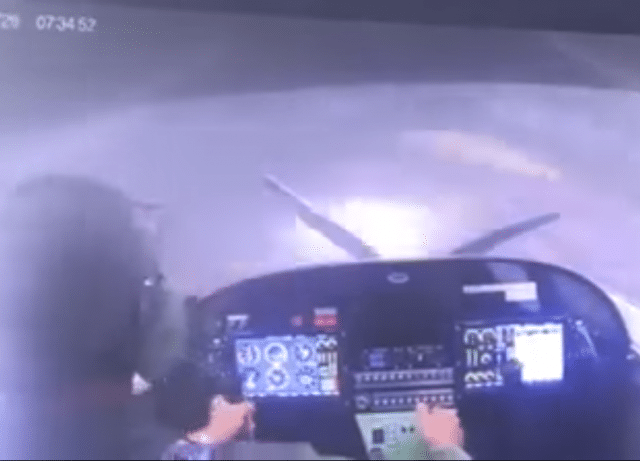Parachute deployed in flat spin at 1,000 feet
This video was posted to a number of aviation forums last week and it’s easy to see why. I literally watched it three times in a row on the spot when I first encountered it.
The clip is from a cockpit video of a pilot in a spin who then deploys the parachute as the ground comes into clear view.
“Dramatic video showing the recent deployment of a BRS ballistic parachute during spin recovery testing of an LSA aircraft. Test pilot became concerned about altitude loss and wisely chose to deploy his recently installed BRS, with no injuries to the pilot and only minor superficial damage to aircraft.”
I couldn’t stop staring at the altimeter as it spins, dropping 3,000 feet in under a minute.
A poster on PPRuNe recognized the pilot, identifying him as Phill Hooker, a test pilot in New Zealand with the nickname Hookz. He quoted Hooker as saying:
I was exploring any flat spin tendencies that this type of aircraft was rumored to get itself into. and yes it did, it would not recover. Deployment at 1000′ (could not do any higher, too long to explain) If you watch the video again, you will notice the front right riser tightened 4 secs before impact.
Apparently his only injury was that he was hit on the head by the canopy as he exited the aircraft.
Identifying the pilot helps to identify the aircraft. Phil Hooker is the test pilot for Triton and it looks like the video shows the Triton Skytrek, a Chinese-built light sport aircraft.
Triton’s Skytrek is newest SLSA; first developed and fabricated in China
Triton is a U.S.-based company (Washington State) but it uses a factory in Zhuhai, China to do the fabrication and it is where New Zealand aerobatic and test pilot Phil Hooker did all the development flying. His NZ pilot license was accepted by Chinese CAAC authorities to do the flying needed to prove the design and to obtain Type Design Approval in China.

It’s kind of funny to read the YouTube comments about this. The commenters are damning, claiming the pilot needed the parachute as a replacement for his flying skills. The top rated posts say that his stick movements were too abrupt, that he wasn’t making effective use of the rudder, that he waited too long to deploy the chute: basically complaining the man did everything wrong, which seem largely based on the fact that he didn’t panic.
In the aviation forums, on the other hand, there’s a quiet respect for his calm handling of the issue. A blessed relief from the macho claims that any idiot could have recovered the plane, the comments instead show an interest in understanding exactly what he was trying to do as the aircraft was plummeting to the ground.
Phill Hooker’s ability to fly an aircraft is not really in question.
Kiwi Flyer Interview Phill Hooker (Hookz), March/April 2012
He has an intimidating array of accomplishments and qualifications to his name, including A-Category Fixed Wing instructor, B-Category Gliding instructor, B-Category Gliding instructor, Flight Expaminor, Authorised Testing Officer for Microlight and Gyros, an airline pilot, commercial helicopter pilot and is the go-to test pilot for many of the other aviators at the airport. With over 100 types in his logbook (and rated on most), Phill is one of the most versatile flight instructors in the country, and can teach you to fly almost anything apart from hot air balloons. He has over 15,000 hours of airtime under his belt.
I think the key point here is recognizing that Hooker wasn’t caught out by a spin and trying to recover. He was specifically investigating the spin characteristics of the aircraft, testing the effects of the stick position and other control inputs before deciding that the aircraft was unrecoverable. One pilot theorized that his statement that he needed to wait to deploy the parachute at 1,000 feet was to avoid winding up the parachute rigging in the spin, which isn’t something that would have occurred to me.
And with that, I’d like to wish you a lovely weekend and a very Merry Christmas!









Cool as an ice cube. ?
The Tiger Moth was also prone to getting into a flat spin. The Dutch RLD (=CAA) imposed a modification, incorporating an enlarged tail fin to prevent getting in a flat spin.
A flat spin is notoriously difficult to get out of. The rotation causes a so-called “centripetal” force in the outward direction from the rotation.
Imagine holding a model of an aircraft, the nose down.
Attach two pieces of string, one to the nose, the other to the tail. Now pull them gently. The force of the strings represents the “centripetal force” and will tend to pull your model in a level attitude.
When that happens, the elevator and rudder will lose their effectiveness, recovery may be very difficult and may require use of bursts of engine power together with full up and down movement of the elevator. But the rotation may cause the engine to stop.
Looking at the video, the rotation rate was quite rapid. The centripetal force may well have been considerable. The descent rate also was quite high, it seemed that only a few seconds lapsed between the pulling of the parachute release and hitting the deck.
A rapid spin can cause disorientation.
In my considered opinion the pilot remained composed, rational and acted in a very deliberate manner.
I would fly with him any time. Even trust my family with him.
Never read YouTube comments, it will destroy your belief in humanity. ;-)
Thank you for a well balanced article. The video was put up without my permission. Arm chair aviators always piss me off
I’m glad you appreciated it, I was a bit shocked when reading the YouTube comments , I have to admit!
Mr Hooker, you are well known here in the States and admired(Aviation community) Please do not confuse the idiots commenting on Y.T. with those of us who respect you and your flying skills.
By the way, great job!!!
It is people like you who prevent lesser skilled pilots like me from being killed by not understanding the characteristics of our aircraft. You tried everything in the book to save the aircraft but only just ended up saving yourself by half a second. Well done and thank you, Sir.
I’d count “only minor superficial damage to aircraft.” as saving the plane!
As the classic said: “… I DO NOT believe …”
the work of the controls at the tester is also classic:
– movements should be SMOOTH, but energetic.
P.S…. everyone thinks of themselves as a strategist when they sit on the couch …
Most airplanes just don’t recover from a flat spin. Certainly all airliners for instance. Criticizing this guy is like holding the BAC1-11 pilots responsible for dying when it’s T-tail was blanked out.